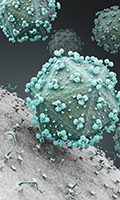AIDS—acquired immunity deficiency syndrome—was named in 1982, at the beginning of the epidemic in the U.S. It was another two years before it was known that human immunodeficiency virus (HIV) was the cause of this strange new disease. Death rates rose steadily and steeply over the next decade. By the mid-1990s, AIDS was the leading cause of death for Americans ages 25 to 44 and more than 250,000 people had died from AIDS or AIDS-related causes.
“Some of our most creative people were taken away from us by this terrible disease,” says Emory synthetic chemist Dennis Liotta. “I became increasingly convinced that I had to do something that would make a difference, even though I didn’t know anything about virology. That was my driving force for getting into it and I never looked back.”
 Death rates began to decline after multidrug therapy became widely available. Emory researchers were front and center in the discovery of this therapy.
Death rates began to decline after multidrug therapy became widely available. Emory researchers were front and center in the discovery of this therapy.
“At the time, we didn’t know too much about HIV. We didn’t know if it was a respiratory virus, we didn’t know if it would affect us personally. But we worked on it because there was a need and an urgency,” says organic medicinal chemist Raymond Schinazi. “When you’re young, you want to save the world. We took the gamble and it paid off.”
HIV is now a chronic, not fatal, diagnosis, largely due to drugs made from compounds that emerged from Emory labs. More than 90 percent of people in the U.S. who have HIV, and many around the world, take at least one of the drugs invented by Emory researchers Liotta, Schinazi, and Woo-Baeg Choi.
Liotta, Professor of Chemistry and Executive Director of the Emory Institute for Drug Development, and Schinazi, Walters Professor of Pediatrics at Emory and Director of the Laboratory of Biochemical Pharmacology, are still hard at work, developing other novel therapeutic agents and furthering vaccine development.
 “This is an incredible example of the impact that academic research can have on people’s lives,” says Todd Sherer, Emory Interim Vice President for Research Administration. “We are very proud that the work by Drs. Liotta, Schinazi and Choi has helped so many people.”
“This is an incredible example of the impact that academic research can have on people’s lives,” says Todd Sherer, Emory Interim Vice President for Research Administration. “We are very proud that the work by Drs. Liotta, Schinazi and Choi has helped so many people.”
Untold numbers of people around the globe have benefitted from this basic research. Go here to watch the story of how the discovery unfolded, and to see patients whose lives were saved by a dark-horse drug regimen that became the most common HIV treatment in the world. Go here to read the full series of blog interviews with inventors, patients, and others.